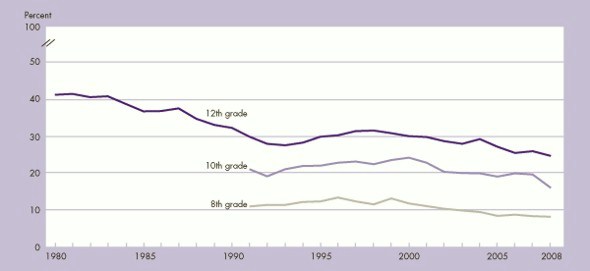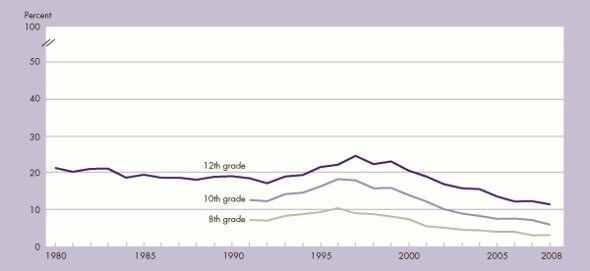 Data regarding students binge drinking (five or more drinks in a row) from 1980 to 2008. Source: The National Institute on Drug Abuse‘s Monitoring the Future Survey.
Data regarding students binge drinking (five or more drinks in a row) from 1980 to 2008. Source: The National Institute on Drug Abuse‘s Monitoring the Future Survey.
In spite of the difficult financial times we currently find ourselves in, there is something to celebrate- Americans and their kids are developing better health habits, especially in the areas of drinking and smoking.
The Federal Interagency Forum on Child and Family Statistics just released its annual report, America’s Children: Key National Indicators of Well Being (2009). It found that “heavy drinking declined from the most recent peak of 13 percent in 1996 to eight percent in 2008 for eight-grade students.”
There was an even greater improvement among 10th-grade students, whose drinking fell from 24 percent in 2000 to 16 percent in 2008.
“We also saw a decline in the percentage of 10th-graders who engage in heavy alcohol consumption- binge drinking,” said Dr. Duane M. Alexander, director of the Eunice Kennedy Shriver National Institute of Child Health and Human Development at the U.S. National Institutes of Health, which participated in the compilation of data for the report.
Also following the trend, overall drinking by 12th-graders also decreased from 32 percent in 1998 to 25 percent in 2008.
 Data regarding students smoking from 1980 to 2008. Source: The National Institute on Drug Abuse‘s Monitoring the Future Survey.
Data regarding students smoking from 1980 to 2008. Source: The National Institute on Drug Abuse‘s Monitoring the Future Survey.
This downward trend was also seen in the level of smoking that teenagers engaged in. The level of smoking in both 12th-graders and 10th-graders decreased by one percent from 2007 to 2008
From year-to-year during this time period, 12th-graders’ smoking decreased from 12 percent to 11 percent, and 10th-graders’ smoking decreased from 7 percent to 6 percent. “This continues a trend in that direction that we have seen over the last several years. We feel our message about the harmful effects of smoking is getting through and making a difference in children’s behavior,” said Alexander.
Eight-graders on the other hand, remained at the same three percent smoking rate from year-to-year during the same time period.
The report also saw a significant decrease in the level of secondhand smoke that children were exposed to.
“Our report shows that the percentage of children who were exposed to a regular smoker dropped from 27 percent in 1994 to only eight percent in 2005. The effects of secondhand smoke are well-documented, so this drop is really good news and tells us that the children are living in healthier conditions,” said Susan Lukacs, a medical officer with the National Center for Health Statistics at the Centers for Disease Control and Prevention.
Further, the U.S. Environmental Protection Agency, which also participated in the compilation of data for the report, finds that “children are particularly vulnerable to the effects of secondhand smoke because they are still developing physically, have higher breathing rates than adults, and have little control over their indoor environments.
“Children exposed to high doses of secondhand smoke, such as those whose mothers smoke, run the greatest relative risk of experiencing damaging health effects.”
Among the health problems that secondhand smoke can contribute to, according to the EPA, are the following:
- asthma in children who have not previously exhibited symptoms.
- increased risk for Sudden Infant Death Syndrome.
- increased risk for middle ear infections.
In addition, infants and children younger than six-years-old who are regularly exposed to secondhand smoke are at increased risk of lower respiratory track infections, such as pneumonia and bronchitis, according to the EPA
Beyond these areas of health concern, the America’s Children report encompassed a wide range of topics in terms of their affects on children’s well-being, such as family structures, education, economic circumstances, and health insurance.